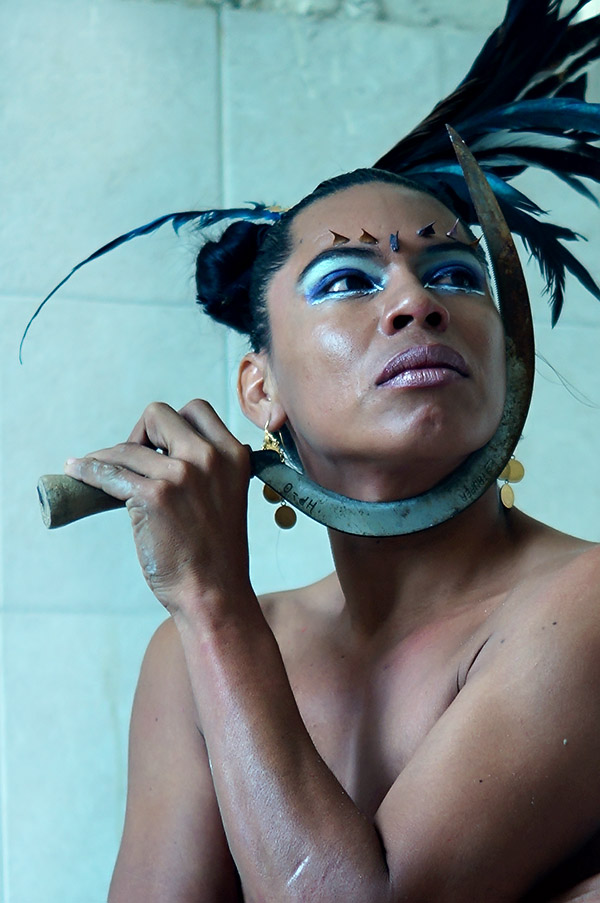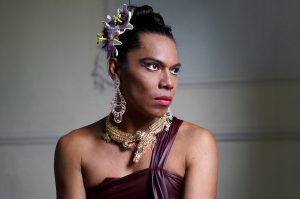Appendix B: Lukas Avendaño: Reflections from muxeidad
Reprinted with permission from Rita Palacios

Lukas Avendaño (1977) is a muxe artist and anthropologist from the Tehuantepec isthmus in Oaxaca. In his work, he explores notions of sexual, gender, and ethnic identity through muxeidad. Avendaño describes muxeidad as “un hecho social total”, a total social fact, performed by people born as men who fulfill roles that are not typically considered masculine. Though it would be easy to make an equivalency between gay and muxe, or transgender and muxe, it can best be described as a third gender specific to Be’ena’ Za’a (Zapotec) culture. Muxes are a community of Indigenous people who are assigned male at birth and take on traditional women’s roles presenting not as women but as muxes. Avendaño’s work is a reflection on muxeidad, sexuality, eroticism, and the tensions that exist around it. Though muxeidad is understood and generally accepted as part of Be’ena’ Za’a society, it exists within a structure that privileges fixed roles for men and women, respectively. It is important to note that his work provides a reflection on muxeidad from within rather than without, that is, he critically explores what it means to be muxe as muxe himself, providing an alternative to academic analyses that can exoticize.
In Réquiem para un alcaraván, Avendaño reflects on traditional women’s roles, particularly in rites and ceremonies of the Tehuantepec region (a wedding, mourning, a funeral), many of which are denied to muxes. For the wedding ceremony, the artist prepares the stage by decorating for the occasion, and then blindfolded, selects a member of the audience who presents as male to marry him. Such a union would not be well regarded in traditional Be’ena’ Za’a society, even though same-sex marriage was recently legalized in Oaxaca, an initiative spearheaded by a muxe scholar and activist, Amaranta Gómez Regalado, in August 2019.
- © Mario Patiño
On May 10, 2018 in Tehuantepec, his younger brother, Bruno Avendaño, disappeared during a brief vacation from his duties in the navy. He hasn’t been found since and the artist has used his platform as an international artist to bring attention to the issue of the disappeared in Mexico. Other artists and activists join him as he travels around the world to show his work and create spaces where he can ask for answers at Mexican consulates and embassies for his brother as well as the 60,000+ individuals that have disappeared in Mexico in the last decade and a half.

Lukas Avendaño (1977) es un artista y antropólogo muxe del istmo de Tehuantepec en Oaxaca. En su obra explora la idea de identidad sexual, de género y étnica a través de la muxeidad. Avendaño describe la muxeidad como “un hecho social total” llevado a cabo por personas nacidas biológicamente como hombres pero que tienen papeles sociales considerados no masculinos. A pesar de ser fácil hacer una equivalencia entre homosexual y muxe, o transgénero y muxe, muxe es un tercer género, único en la sociedad Be’ena’ Za’a (Zapoteca). Los muxes conforman una comunidad de personas indígenas a quienes se les asigna el género masculino al nacer y asumen roles tradicionales femeninos, presentándose como muxes mas no como mujeres. En el trabajo de Avendaño se hace una reflexión sobre la muxeidad, sexualidad, erotismo y las tensiones que surgen. Aunque la muxeidad es entendida y aceptada como parte de la sociedad Be’ena’ Za’a, esta existe dentro de una estructura que privilegia los roles fijos de hombres y mujeres, respectivamente. Es importante notar que el trabajo de Avendaño presenta una reflexión sobre la muxeidaddesde dentro y no desde fuera; es decir el artista explora de manera crítica lo que significa ser muxe siendo muxe él mismo, así presentando una alternativa a los análisis académicos que pueden exotizar.
En Réquiem para un alcaraván, Avendaño reflexiona sobre los roles tradicionales femeninos, en particular en los ritos y tradiciones de la región de Tehuantepec (una boda, un velorio y un funeral), muchos de los cuales les son negados a los muxes. Para la ceremonia matrimonial, el artista prepara el escenario decorándolo y luego, con los ojos vendados, escoge a un miembro del público, un hombre, para casarse con él. Este tipo de unión no es bien vista en la sociedad Be’ena’ Za’a tradicional aun cuando el matrimonio igualitario haya sido aprobado por el congreso de Oaxaca gracias a la iniciativa de la intelectual y activista muxe Amaranta Gómez Regalado, en agosto del 2019.
El 10 de mayo de 2018, el hermano menor del artista, Bruno Avendaño, desapareció durante sus vacaciones en la Marina. Desde entonces no se sabe nada de él y Lukas ha utilizado su plataforma como artista internacional para visibilizar el problema de la desaparición en México. Otros artistas y activistas lo acompañan cuando viaja alrededor del mundo para mostrar su trabajo y crear espacios donde puede exigir respuestas sobre el paradero de su hermano y del de más de 60,000 individuos que han desaparecido en la última década y media en México.
Media Attributions
- Lukas-Avendaño-1
- Lukas-Avendaño-4



